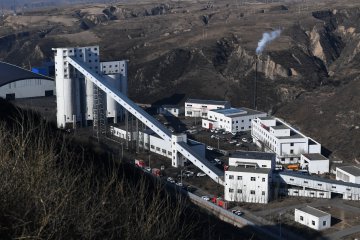
Is Chinese coal consumption in terminal decline or ramping up again? The fortunes of the global coal mining industry, and of attempts to limit global carbon emissions, could depend on the answer.
Both climate-change activists and miners see reasons for hope. The former can point to the long-term decline of coal as a percentage of Chinese electricity capacity: 60% now, down from nearly 80% in the mid-2000s. Coal barons can point to rebounding coal use recently: Chinese output hit 320 million tons in December, its highest since 2015. Overall coal consumption ticked up for the first time since 2013 last year, despite a slowing economy. China remains by far the world’s largest consumer of the fuel.
There are reasons to be skeptical consumption will keep growing. Wealthier Chinese citizens are fed up with terrible air pollution, and Beijing is listening. President Xi Jinping, in his keynote Party Congress speech in October 2017, said that China was already close to becoming a moderately prosperous society and needs to give the people a “wonderful life,” not just material prosperity. Environmental enforcement has become far stricter over the past two years, and imports of cleaner-burning natural gas have surged.
There is one very strong caveat, though: China’s coal-heavy power sector is among its most indebted, with $1.3 trillion of liabilities in early 2019, roughly twice as large as those of the debt-addled iron-and-steel sector, which gets more attention. Years of overinvestment paired with higher coal prices since 2016 have punished power-sector finances. Huaneng Power International , the listed arm of one of China’s largest power producers, posted its lowest net income since 2008 last year, though its net debt has more than doubled. The sector is struggling to finance itself even with borrowing costs beginning to fall—operating profits were only two times interest payments for the sector as a whole in 2018, down from nearly 3.5 times as recently as 2016. Return on assets has nearly halved since 2015 and is now over three percentage points lower than the average bank borrowing rate.
Chinese leaders want their middle-class citizens breathing cleaner air, but they also want to avoid infrastructure debt blow-ups. One obvious way to do this is to make sure coal prices—and power plants’ costs—don’t rise too high. That means allowing moderate increases in domestic coal supply when sector finances come under too much pressure, as now.
In other words, further sharp falls in Chinese coal burn probably require some solution to power-sector financial problems. If Beijing bites the bullet, does a big bank recapitalization and writes off debts, that could happen quickly. So far, though, there is little sign of anything so ambitious. Otherwise, those hoping for a cleaner power sector may have to endure a long, slow deleveraging as those electricity plants whittle down their vast debts.
Source: The Wall Street Journal




















Latest comments